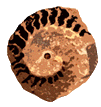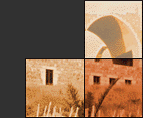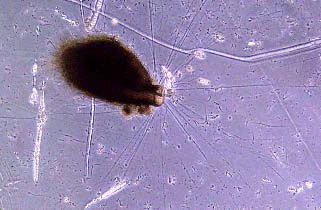

 Home
Home 

Micro Fossils
|
|
>> Microfossils from Jordan
Text & images by Dr. A. Smadi
Importance of Microfossils
Microfossils are the tiny remains of bacteria, protists, fungi, animals, and plants. Microfossils, unlike other kinds of fossils, are not grouped according to their relationships to one another, but only because of their generally small size and methods of study. For example, fossils of bacteria, foraminifera, diatoms, very small invertebrate shells or skeletons, pollen, and tiny bones and teeth of large vertebrates, among others, can be called microfossils.
Microfossils are perhaps the most important group of all fossils — they are extremely useful in age-dating, correlation and paleoenvironmental reconstruction, all important in the oil, mining, engineering, and environmental industries, as well as in general geology. Because they usually occur in huge numbers in all kinds of sedimentary rocks, they are the most abundant and most easily accessible fossils. Indeed, some very thick rock layers are made entirely of microfossils. The pyramids of Egypt are made of sedimentary rocks, for example, that consist of the shells of foraminifera, a major microfossil group.
Microfossils
Although plants and animals are the most obvious life around us today, they are not the most numerous nor the most important contributors of microfossils. Bacteria (prokaryotes) and protists far outnumber them, live in more diverse habitats, and leave a greater diversity of microfossils. Today these organisms live from Antarctic ice deserts to steaming volcanic hot springs, and from the highest mountains to the deepest sea. Some cause diseases, such as malaria, which infects 350-400 million people today; others are useful to humans. Most simply live their lives unknown to us but contributing enormously to our well being through the production of oxygen, the degradation of waste materials, recycling of nutrients, production of food, and a multitude of other functions, some of which take place in our own bodies. Fungi, plants, and animals contribute a vast multitude of small parts to the microfossil record. Fungi are found as isolated microscopic filaments and spherical spores, usually associated with larger fossil plant material. Many plants have small pieces and parts that can be found as microfossils. Most important of these are pollen and spores, which can be very abundant in terrestrial and near shore marine deposits. Just about any animal with skeletal parts also contributes to the microfossil record.
Some Forams and Nannos form Jordan
Foraminifera (forams for short) are single-celled protists with shells. Their shells are also referred to as tests because in some forms the protoplasm covers the exterior of the shell. The shells are commonly divided into chambers which are added during growth, though the simplest forms are open tubes or hollow spheres. Depending on the species, the shell may be made of organic compounds, sand grains and other particles cemented together, or crystalline calcite. Fully grown individuals range in size from about 100 micrometers to almost 20 centimeters long. A single individual may have one or many nuclei within its cell. The largest living species have a symbiotic relationship with algae, which they "farm" inside their shells. Other species eat foods ranging from dissolved organic molecules, bacteria, diatoms and other single celled phytoplankton, to small animals such as copepods. They move and catch their food with a network of thin extensions of the cytoplasm called reticulopodia, similar to the pseudopodia of an amoeba, although much more numerous and thinner.
Forams can be found within marine environments, either floating - planktonic, or on sea floor - Benthonics. Forams appeared 450 MYA i.e. late Ordovician [Ordovician period: 505 - 408 MYA]

A typical foram : In the picture about,
the dark brown structure is the test, or shell, inside which the foram
lives. Radiating from the opening are fine hairlike reticulopodia, which
the foram uses to find and capture food.
Calcareous nannofossils are fossil remains of golden-brown, single-celled algae that live only in the oceans. Because they are plants they need sunlight, so they float near the surface of the water. There are billions and billions of them living in the oceans today, and they are eaten by anything that is bigger than they are. They are one of the primary organisms at the base of the food chain. These algae make tiny calcite platelets inside their cells, and these platelets (the calcareous nannofossils or nannos for short) move to the surface of the cell. No one is certain why these platelets are formed, but after a while they fall off the cell and slowly drift down to the bottom of the ocean. These platelets are replaced by new ones that constantly are forming within each cell. As these platelets land on the bottom of the ocean, they are slowly covered up with remains of other plants and animals and bits of mud and sand that have washed out with the rivers of the world. At this point they are part of a mud or marl or sandy clay. Eventually, there are many sediments on the ocean bottom, and their weight is enough so that the lowest sediments are squeezed enough to become rocks. If these rocks are almost entirely made of nannos, they are a chalk. If there aren't so many nannos, they can be part of a limestone or shale. These calcite platelets are preserved in the rocks and are the fossils that paleontologists study.
Calcareous nannofossils have been living in the
world's oceans for at least 210 MYA i.e. from the Late Triassic [Triassic
period: 248 - 208 MYA] and they have evolved and changed constantly over
time.

This collection is from different locations covered by a PhD research "Planktonic Biostrategraphy of Jordan, through the Cretaceous - Paleocene Succession", conducted by Smadi, 2000.
Sixty-one species and sub-species of Plankton Foraminifera related to 21 genera and 50 calcareous Nannofossils species related to 25 genera. Nine biozones of calcareous Nannofossils were recognized in the study area.
The studied geographical areas:
1. Arramtha, and Husha, Northern Jordan.
2. Qasr Hallabat, Qasr Mushash, Shuwaer and Azraq, Central and Eastern
Jordan.
3. Ma'an, Southern Jordan.